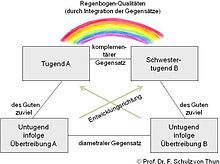Value and development square
The by Nicolai Hartmann coming (1926) values Square has Friedemann Schulz von Thun 1989 for the needs of interpersonal communication used and connected to the idea of development and values and development square called.
With the help of the value and development square, it could be possible to find the necessary counter-quality (“sister virtue ”) for every human quality (e.g. honesty) (here e.g. tact and sensitivity); only both together let “the rainbow open” . Honesty without tact can degenerate into brutal openness, tact without honesty into a polite facade. If one has the balance of two countervalues in mind, one can also discover the upcoming direction of development : one of them tends to make honesty absolute and must accordingly conquer tact and sensitivity; the other is exaggerating exactly this quality and should learn to speak honestly plain language.
The basic idea of the model can be traced back to Aristotle (approx. 350 BC), was further developed by Nicolai Hartmann (1926) and finally borrowed for psychology from Paul Helwig (1936).
Hartmann's original example
Nicolai Hartmann translated the Aristotelian idea into a square of values and Paul Helwig took it over from him. In the example that has appeared again and again since Aristotle, generosity is required in addition to frugality in order not to degenerate into a curmudgeon and, conversely, the balance with frugality protects the generous from wasting.
The direction of development can be found in the diagonals. Those who exaggerate thrift and become stingy, whose development arrow points to generosity and complementarily recommend it for the wasteful to develop thrift.
The premise of the value and development square of Schulz von Thun is: Every value (every virtue , every guiding principle, every human quality) can only develop its full constructive effect if it is in sustained tension to a positive equivalent , a "sister virtue " am located. Without this balance, the rainbow could not open, a value would degenerate into its devalued exaggeration . Here Schulz von Thun distances himself from Aristotle and von Hartmann, since he uses the terms value and virtue in the same way, while for Aristotle virtue consists in the continuous balancing of tension values.
Applications
In this spirit, Schulz von Thun's value and development square is also used for appraisal interviews or for feedback after an assessment center . It is also used in modern HR work as a basis for 360 ° feedback . The demonstration of behavior is based less on deficits than on strengths.
literature
- Friedemann Schulz von Thun: Talking to each other 2. Styles, values and personal development. Reinbek near Hamburg 1989
- Friedemann Schulz von Thun: Talking to each other: questions and answers. Reinbek near Hamburg 2007, pp. 49-76, ISBN 978-3-499-61963-2 .
Individual evidence
- ↑ Jutta Herder, Kirsten Wallmichrath: Moving away from black and white thinking - SIG Combibloc and meta | five develop a 360 ° feedback based on the value square approach ; Article in personal magazine MANAGEMENT, RECHT UND ORGANIZATION, November 2010, 12/2010, pages 38–40

